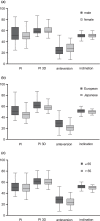Is there a correlation between pelvic incidence and orientation of the acetabulum? An analysis based on a three-dimensional statistical model of the pelvic ring
- PMID: 35662008
- PMCID: PMC9358766
- DOI: 10.1111/joa.13708
Is there a correlation between pelvic incidence and orientation of the acetabulum? An analysis based on a three-dimensional statistical model of the pelvic ring
Abstract
The pelvic ring is a complex anatomical structure building up the connection between the trunk and the legs. Whilst there is a broad discussion in the literature about the dynamic interaction between spine, pelvis and the hip joints, there is still little information about the relation and interaction of the constant pelvic parameters. Based on a three-dimensional (3D) statistical model consisting of 150 uninjured and bony healthy pelves (100 Europeans, 50 Japanese; 81 males, 69 females; average age 74.3 years ± 17.5 years) an evaluation of pelvic incidence (PI) and acetabular orientation in anteversion and inclination was performed and potential correlations of these intraindividual constant parameters were investigated. Pelvic incidence is defined as the angle between the perpendicular to the sacral plate at its midpoint and the line connecting this point to the middle axis of the femoral heads. Acetabular anteversion is defined as the angle between the perpendicular to the best-fit plane on the acetabular rim and the coronal plane measured in strict lateral view. Acetabular inclination is defined as the angle between the perpendicular to the best-fit plane on the acetabular rim and the sagittal plane in strict frontal view. Data were further analysed with regard to different subgroup's age, sex and ethnicity. A positive correlation between PI and acetabular anteversion could be demonstrated. Further, PI and also the acetabular parameters anteversion and inclination were found to be significantly higher in the European individuals than in the Asian. The results of the present study demonstrate a relation between the anatomical configuration of the constant pelvic parameters building up the connection points to the next proximal respectively caudal skeleton section. The findings might lead to more comprehensive treatment strategies in case of trauma or degenerative pathologies of the pelvis in the future.
Keywords: 3D statistical model; acetabular anteversion; acetabular inclination; acetabular orientation; pelvic incidence; pelvic ring.
© 2022 The Authors. Journal of Anatomy published by John Wiley & Sons Ltd on behalf of Anatomical Society.
Figures









Similar articles
-
Changes of acetabular anteversion according to pelvic tilt on sagittal plane under various acetabular inclinations.J Orthop Res. 2021 Apr;39(4):806-812. doi: 10.1002/jor.24790. Epub 2020 Jul 10. J Orthop Res. 2021. PMID: 32603527
-
[Two key describers of the sacro-acetabular relationships: the angles of sacral and acetabular incidence].Rev Chir Orthop Reparatrice Appar Mot. 2008 Jun;94(4):327-35. doi: 10.1016/j.rco.2007.11.008. Epub 2008 Apr 3. Rev Chir Orthop Reparatrice Appar Mot. 2008. PMID: 18555858 French.
-
Does hemipelvis structure and position influence acetabulum orientation?BMC Musculoskelet Disord. 2016 Mar 16;17:131. doi: 10.1186/s12891-016-0982-2. BMC Musculoskelet Disord. 2016. PMID: 26984181 Free PMC article.
-
The Influence of Pelvic Tilt on the Anteversion Angle of the Acetabular Prosthesis.Orthop Surg. 2019 Oct;11(5):762-769. doi: 10.1111/os.12543. Orthop Surg. 2019. PMID: 31663281 Free PMC article. Review.
-
[Morpho-metrical features of the pelvis in standing posture].Kaibogaku Zasshi. 2000 Apr;75(2):223-30. Kaibogaku Zasshi. 2000. PMID: 10824514 Review. Japanese.
Cited by
-
Quantitative evaluation of correlation between lumbosacral lordosis and pelvic incidence in standing position among asymptomatic Asian adults: a prospective study.Sci Rep. 2022 Nov 8;12(1):18965. doi: 10.1038/s41598-022-21840-x. Sci Rep. 2022. PMID: 36347920 Free PMC article.
-
Development of a Statistical Shape Model and Assessment of Anatomical Shape Variations in the Hemipelvis.J Clin Med. 2023 May 30;12(11):3767. doi: 10.3390/jcm12113767. J Clin Med. 2023. PMID: 37297962 Free PMC article.
-
Normative values of the sagittal lumbopelvic alignment in children during the first decade of life : A retrospective observational study from a German paediatric orthopaedic hospital.Eur Spine J. 2025 Jul 14. doi: 10.1007/s00586-025-09107-1. Online ahead of print. Eur Spine J. 2025. PMID: 40659962
References
-
- Celestre, P.C. , Dimar, J.R., 2nd & Glassman, S.D. (2018) Spinopelvic parameters: lumbar lordosis, pelvic incidence, pelvic tilt, and sacral slope: what does a spine surgeon need to know to plan a lumbar deformity correction? Neurosurgery Clinics of North America, 29(3), 323–329. - PubMed
-
- Eftekhary, N. , Shimmin, A. , Lazennec, J.Y. , Buckland, A. , Schwarzkopf, R. , Dorr, L.D. et al. (2019) A systematic approach to the hip‐spine relationship and its applications to total hip arthroplasty. Bone & Joint Journal, 101‐B(7), 808–816. - PubMed
Publication types
MeSH terms
Grants and funding
LinkOut - more resources
Full Text Sources
Research Materials
Miscellaneous

